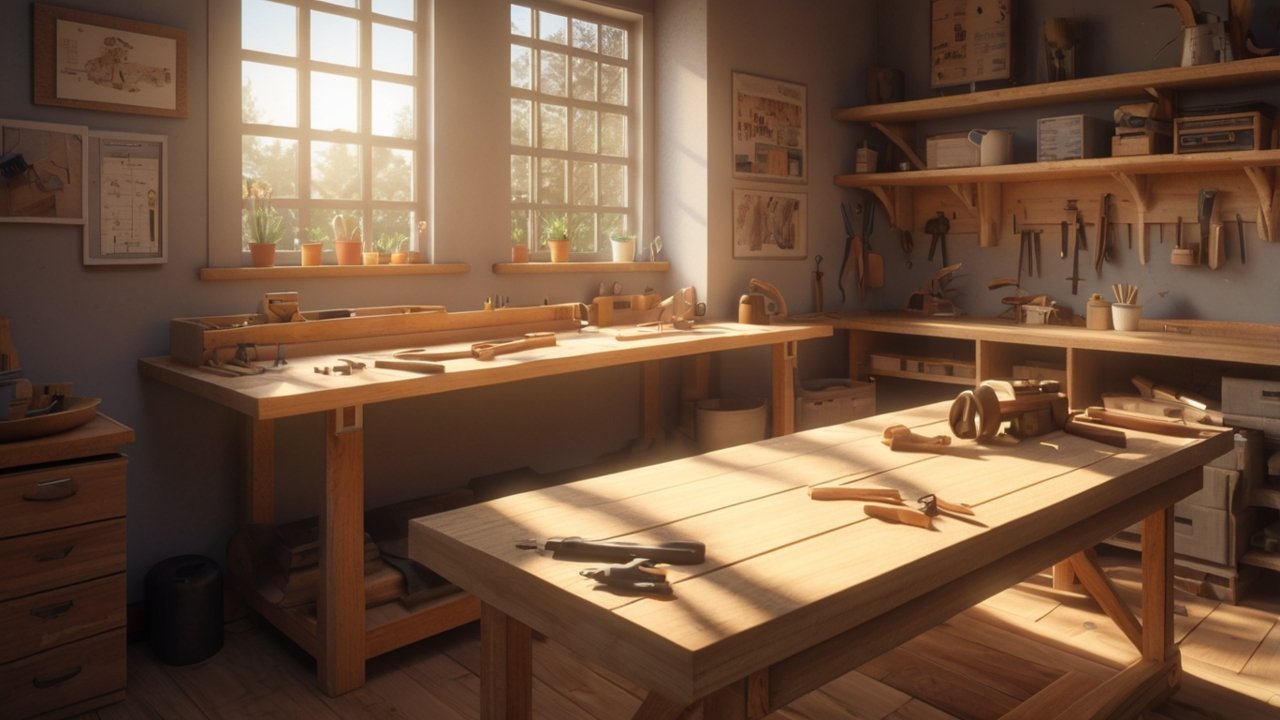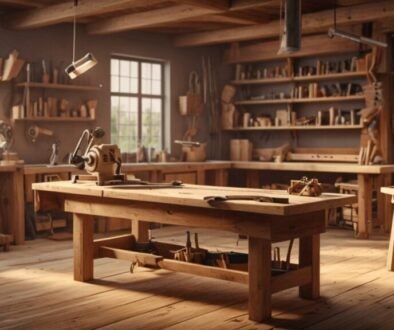Beginner Woodworking Projects: 10 Easy Builds to Try
Thinking about picking up a new hobby but not sure where to start? Beginner woodworking projects are a great way to build confidence, learn practical skills, and create something you can actually use. You don’t need a fancy workshop or years of experience—just a few basic tools, a bit of patience, and the right starter ideas.
Whether you’re looking for easy woodworking projects to do over the weekend or want to make handmade gifts without breaking the bank, beginner woodworking projects offer the perfect blend of simplicity and satisfaction. These small builds are budget-friendly, approachable, and designed to help you learn by doing.
In this guide, you’ll discover 10 project ideas that are ideal for first-timers—each one selected to help you gain hands-on experience without feeling overwhelmed. From key holders to planter boxes, we’ll cover a variety of simple woodworking projects you can actually complete (and be proud of).
Let’s dive into the best beginner woodworking projects you can start building today.

🛠️ Chapter 1: What You Need to Get Started with Beginner Woodworking Projects
Starting out in woodworking can feel overwhelming—but it doesn’t have to be. The beauty of beginner woodworking projects is that you can do a lot with just a handful of basic tools and materials. You don’t need a full-blown workshop or thousands of dollars in gear. All you need is a smart approach, the right tools, and a few tips from those who’ve been there.
This section covers the essential tools, safety basics, and materials every beginner needs to get started—with affordable options and real-world insights to help you avoid wasting time and money.
🧰 Essential Tools for Beginner Woodworking Projects (Without Breaking the Bank)
You don’t need a garage full of power tools to build quality beginner woodworking projects. Many first-timers start with just five or six items and gradually upgrade as their skills grow.
🧱 Start with these foundational tools:
-
Tape Measure – Accuracy matters more than power.
-
Claw Hammer – Perfect for nails, fitting parts, and minor demo work.
-
Speed Square – Helps you make accurate right-angle cuts.
-
Cordless Drill/Driver – Versatile and essential for drilling holes and driving screws.
-
Jigsaw – Great for curved cuts and irregular shapes.
-
Clamps – A few strong clamps make gluing and holding parts easier and safer.
-
Sanding Block or Orbital Sander – Smooths your final product and keeps splinters away.
🔗 Want to build a full shop in a small space?
👉 Click here to explore this recommended DIY solution that shows how to set up a compact woodworking area on a budget.
🧠 Pro Tip: You don’t need to buy everything new. Check local Facebook Marketplace listings, garage sales, or even your local Habitat for Humanity ReStore for used tools.
🌲 Choosing the Right Wood for First Projects
Picking the wrong wood can turn a simple project into a frustrating mess. For beginner woodworking projects, the goal is to use easy-to-handle, affordable lumber that’s available at most home centers.
✅ Best wood types for beginners:
-
Pine – Cheap, lightweight, and easy to cut.
-
Poplar – Slightly harder than pine, good for painting.
-
Cedar – Smells great and resists rot, ideal for outdoor projects.
📚 Learn more: Types of Wood – Complete Guide for Every Project →
⚠️ Avoid hardwoods like oak or walnut at the start—they’re dense, expensive, and dull your blades faster.
🦺 Woodworking Safety Tips Every Beginner Must Know
Woodworking is fun—but safety always comes first. Whether you’re cutting, drilling, or gluing, staying alert and properly equipped helps prevent injuries.
👇 Safety must-haves:
-
Safety glasses – Always protect your eyes from flying dust or splinters.
-
Dust mask or respirator – Especially when sanding.
-
Ear protection – If using loud power tools like circular saws or sanders.
-
Work gloves – When handling rough lumber or applying finishes.
🧪 According to Fine Woodworking Magazine, most beginner injuries occur due to improper handling of basic hand tools—not advanced machinery. Start slow and read tool manuals. Respect the tool and the material.
⚖️ DIY vs Buying Pre-Made — What’s the Better Route?
Should you just buy furniture instead of building it yourself? That depends on your goals.
| DIY Builds | Buying Pre-Made |
|---|---|
| ✔️ Cheaper in the long run | ✔️ Instant results |
| ✔️ Customizable design | ✔️ Less time-consuming |
| ✔️ Skills development | ❌ Less rewarding |
| ❌ Time investment | ❌ Can be more expensive |
👉 Want step-by-step plans designed for beginners?
Check out these affordable woodworking plans →
🏠 Set Up a Simple Workspace for Beginner Woodworking Projects
You don’t need a full workshop to start. Many successful hobbyists work from patios, basements, or even a corner of their apartment.
✅ Basic workspace checklist:
-
Flat surface (folding table, workbench, or even plywood on sawhorses)
-
Good lighting (natural is best)
-
Access to power outlets
-
Shelf or tote box to store tools
🪚 Want to build a full mini-workshop in a weekend?
See how you can build your own shed with this step-by-step guide.
🔗 Internal Links to Deepen the Journey
🧩 Final Thoughts
The hardest part of woodworking is often just starting. But with the right mindset, a few affordable tools, and some clear beginner-friendly project plans, you can build real, useful items even on your first try. As you dive into your first beginner woodworking projects, remember: perfection isn’t the goal—progress is.
🛠️ Ready to build your first project? Jump to the 10 beginner builds → and pick the one that excites you most.

🌳 Chapter 2: 10 Beginner Woodworking Projects You Can Actually Build
If you’re new to woodworking, the best way to learn is by doing. The following beginner woodworking projects are carefully chosen to help you practice key skills—measuring, cutting, drilling, sanding—while creating something functional and rewarding. Each project is beginner-friendly, requires only basic tools, and can often be completed in a weekend or less.
Let’s break down 10 great DIY woodworking builds, complete with skill level, estimated time, and optional upgrades.
🪵 1. Simple Wooden Storage Box
-
Time: 2–3 hours
-
Skill Level: Easy
-
Tools Needed: Saw, drill, screws, clamps
A wooden box may sound basic, but it’s the perfect first build. It teaches measuring, cutting, joining, and finishing—all in one go. Use it to store tools, books, or toys.
🧰 Pro Tip: Add rope handles or a lid for a custom touch.
📌 Learn to finish it like a pro: Best Polyurethane Finishes for Wood →
🔑 2. Wall-Mounted Key Holder
-
Time: 1–2 hours
-
Skill Level: Easy
-
Tools Needed: Saw, drill, sandpaper
Small but useful, a key holder adds instant organization to any entryway. You’ll learn how to drill clean pilot holes and mount hooks securely.
🛠️ Looking for a compact workspace idea?
👉 Click here to explore this recommended DIY solution
🌿 3. Outdoor Planter Box
-
Time: 3–4 hours
-
Skill Level: Beginner
-
Tools Needed: Saw, drill, screws, clamps
Great for patios or windowsills, a cedar planter box gives you practice with angled cuts and weatherproofing.
📚 Related: Types of Wood for Outdoor Use →
📚 4. Basic Bookshelf
-
Time: 4–5 hours
-
Skill Level: Moderate beginner
-
Tools Needed: Drill, jigsaw, clamps, square
Want to build something useful for your home? A small two-shelf bookcase helps you learn how to keep cuts square and secure your structure properly.
🪚 Want a full set of beginner-friendly plans?
👉 Check out these affordable woodworking plans →
🐦 5. Birdhouse
-
Time: 2–3 hours
-
Skill Level: Easy
-
Tools Needed: Saw, drill, screws
A classic beginner woodworking project. Birdhouses teach you to work with small parts, drill entry holes, and assemble pieces with precision. Plus, they’re fun for kids and great for the backyard.
☕ 6. Wooden Coasters Set
-
Time: 1 hour
-
Skill Level: Very easy
-
Tools Needed: Saw, sander
Scrap wood becomes stylish drink coasters in minutes. This is a great quick project if you want to practice sanding and finishing techniques without committing to a bigger build.
👟 7. DIY Shoe Rack
-
Time: 4–5 hours
-
Skill Level: Beginner
-
Tools Needed: Saw, drill, square, screws
Tired of messy hallways? A two-tier shoe rack helps you practice repetition (same cut lengths), load-bearing structure, and screwing into softwood cleanly.
💡 Add a coat of paint or stain to make it blend into your entryway.
🔧 8. Tool Organizer
-
Time: 2 hours
-
Skill Level: Beginner
-
Tools Needed: Drill, saw, measuring tape
If you’re building more projects, you’ll want to keep tools accessible. Wall-mounted organizers are an efficient way to store screwdrivers, pliers, and drill bits—all while learning how to mount and balance wood pieces.
🪞 9. Floating Wall Shelf
-
Time: 2–3 hours
-
Skill Level: Moderate beginner
-
Tools Needed: Drill, level, screws, anchors
Learn about anchoring into drywall and making a sleek, minimalist shelf that actually holds weight. This project blends utility with clean design.
🔨 Want to build out your home storage?
👉 See how you can build your own shed with this step-by-step guide.
📱 10. Wooden Phone Stand
-
Time: 1 hour
-
Skill Level: Very easy
-
Tools Needed: Saw, sandpaper
Perfect for desks, nightstands, or as a gift. A basic two-piece interlocking phone stand is a great intro to joinery and ergonomics.
🎯 Choosing the Right Project for Your Skill Level
Not sure where to begin? Start with the project that solves a real need in your home. Here’s a quick breakdown to guide your pick:
| Skill Level | Projects to Try |
|---|---|
| Total Beginner | Coasters, key holder, phone stand |
| Beginner | Box, birdhouse, planter box |
| Moderate Beginner | Bookshelf, shoe rack, wall shelf |
🔗 Internal Links to Continue Reading
💬 Real-World Tip from the DIY Community
“My first woodworking project was a planter box. I didn’t even own a sander—I used sandpaper by hand. It wasn’t perfect, but it gave me the confidence to try more.”
— Maggie R., r/BeginnerWoodworking
✅ Ready to Build?
You don’t need a garage full of tools to make something useful and rewarding. These beginner woodworking projects give you a solid foundation, and every cut, screw, and sanding stroke builds your confidence.

📚 Chapter 3: Where to Find Free Woodworking Plans and Tutorials
One of the biggest mistakes beginners make? Winging it without a plan.
The internet is full of free woodworking plans and step-by-step tutorials that can help you go from “I have no idea what I’m doing” to confidently completing your first few beginner woodworking projects—without wasting time, money, or wood.
This chapter shows you where to get reliable, easy-to-follow plans that match your skill level, budget, and available tools. Whether you prefer videos, PDFs, or blog tutorials, these resources are trusted by the DIY community and updated regularly.
🛠️ Why You Need Plans for Beginner Woodworking Projects
Even if you’re just making a box or a shelf, working from a proper plan makes a big difference. Here’s why:
✅ Benefits of Using Free DIY Woodworking Plans
-
Saves money – Avoid buying the wrong materials or making costly mistakes.
-
Boosts confidence – Clear measurements and visual guides reduce guesswork.
-
Teaches fundamentals – Learn proper techniques from experienced woodworkers.
-
Results you can be proud of – Your project looks like the picture (and holds together).
🔎 Fun Fact: According to Wood Magazine, beginner woodworkers who use detailed plans are 63% more likely to finish their first project successfully.
🌐 Best Websites for Free Woodworking Project Plans
Let’s break down the top sources where you can download or follow free beginner woodworking project plans that are clear, accurate, and totally no cost.
🪵 1. DIY Woodhaven – 10 Easy Projects for Beginners →
A great starting point. Simple builds like planter boxes, phone stands, and key holders—with free step-by-step instructions tailored for beginners. The site also explains tools and materials in plain English.
📏 2. Ana White
One of the most trusted names in the DIY space. Ana White’s website features hundreds of free downloadable PDF plans, including furniture and small builds. Every plan includes a cut list and tools needed.
📹 3. YouTube Channels
Prefer learning by watching? Try these channels:
-
Steve Ramsey – Woodworking for Mere Mortals
Focused entirely on beginner projects and tool tips. -
Fix This Build That
Great mix of small shop tips and affordable builds. -
April Wilkerson
Excellent for practical builds and clear explanations.
🎥 Want visual walkthroughs and tool setup tips?
👉 Check out this recommended DIY solution for small workshop setup →
💾 Where to Download Free Printable Woodworking Plans
For those who like printouts, cut lists, and diagrams, here are your go-to sources:
-
Instructables Woodworking Section
Community-contributed projects with photos and comments. -
Woodsmith Plans (limited free selection)
Professional-grade, highly detailed plans. -
The Spruce Crafts
Project galleries with instructions and materials lists.
🔗 Internal Resource: Types of Wood for Furniture Projects →
🏠 Want More Than Just One-Off Plans?
If you’re serious about learning and want a complete set of structured beginner plans…
👉 Check out these affordable woodworking plans →
You’ll get:
-
12,000+ plans for all levels
-
Easy-to-read instructions
-
Projects for furniture, outdoor, storage, and more
-
Designed for beginners and hobbyists
“MyShedPlans was a game-changer for me. I went from zero to building custom furniture for my home in 3 months.”
— Josh, verified user
🤔 How to Know If a Woodworking Plan Is Beginner-Friendly
Not all free plans are created equal. Before starting any project, make sure it checks the following boxes:
📌 Beginner Plan Checklist:
-
✅ Step-by-step instructions
-
✅ Cut list and measurements
-
✅ Tool list (and doesn’t assume you own a full shop)
-
✅ Diagrams or build photos
-
✅ Estimated time and difficulty level
💡 Avoid plans that use complex joinery (like dovetails) unless you’re ready for a challenge.
💬 Learn from the Community: Forums and DIY Groups
Joining woodworking communities can give you feedback, motivation, and troubleshooting help.
-
r/BeginnerWoodworking (Reddit) – Great for sharing your progress and getting answers
-
LumberJocks – Forum for DIYers, hobbyists, and pros
-
Facebook Groups – Search for “Woodworking for Beginners” to find active groups
🔎 Still overwhelmed?
👉 See how you can build your own tiny workshop space step-by-step.
🎯 Final Word: Don’t Just Scroll—Build Something
Finding the right plan is the first step toward creating something with your own hands. Whether you’re making a bookshelf, a birdhouse, or a phone stand, having clear instructions helps eliminate fear and builds confidence.
You’ve now got the tools and the blueprints—what’s stopping you?
👉 Start your next project with these beginner-friendly woodworking plans →

⚠️ Chapter 4: Common Beginner Mistakes to Avoid in Woodworking
Starting your first few beginner woodworking projects can be exciting—but also overwhelming. It’s easy to rush into a project without realizing you’re making avoidable mistakes that can waste materials, damage tools, or worse, cost you your confidence.
In this chapter, we’ll break down the most common mistakes beginner woodworkers make, explain why they happen, and give you realistic, easy fixes so you can avoid them from the start.
🪚 Mistake #1 – Skipping the Plan
Jumping into a build with just an idea (or a YouTube screenshot) might feel spontaneous—but it’s a recipe for frustration.
Why it’s a problem:
-
Leads to poor measurements or misaligned parts
-
Wastes time re-cutting or rebuilding
-
Increases material costs
Easy fix:
Always follow a clear step-by-step guide—especially when learning.
👉 Check out these affordable woodworking plans →
Includes cut lists, tool breakdowns, and beginner tips for over 12,000 projects.
📌 Internal Tip: See 10 Easy Projects for Beginners →
📏 Mistake #2 – “Measure Once, Cut Twice”
You’ve probably heard the saying “Measure twice, cut once.” There’s a reason it’s repeated so often—it prevents costly errors.
Common causes:
-
Rushing the process
-
Misreading your tape measure
-
Forgetting to account for blade width (kerf)
Pro tip:
Use a pencil to mark clearly and a speed square to double-check angles.
“I ruined my first shelf because I didn’t account for the kerf. It was 1/8” off and didn’t fit. Lesson learned.”
— Jeff P., Beginner Woodworking Forum
🪵 Mistake #3 – Choosing the Wrong Wood
Not all wood is created equal, and some species are much harder to work with than others—especially if you’re using entry-level tools.
Avoid for beginners:
-
Oak, walnut, maple (dense, tough on blades)
-
Pressure-treated lumber (can contain chemicals)
Stick with:
-
Pine
-
Poplar
-
Cedar (for outdoor use)
📚 Learn more: Complete Guide to Wood Types →
🛠️ Mistake #4 – Overcomplicating the First Project
Trying to build a farmhouse table or custom cabinet as your first project is like running a marathon without training.
Instead, start with:
-
Coasters
-
Key holder
-
Planter box
These builds are simple but still teach core skills like measuring, drilling, and sanding—without overwhelming you.
👉 See how to set up a small workshop step-by-step →
🔌 Mistake #5 – Misusing (or Not Respecting) Tools
Tools are there to help—but they’re only as safe as your knowledge and respect for them.
Dangerous beginner habits:
-
Using the wrong blade
-
Removing safety guards
-
Holding workpieces improperly
Solution:
-
Watch tool tutorials (YouTube, forums)
-
Read manuals (they’re short and useful!)
-
Use push sticks, clamps, and safety gear
🧠 Did you know? Fine Woodworking reports over 70% of beginner tool injuries involve improperly secured wood or ignored safety guides.
🎯 Mistake #6 – Ignoring Finishing Techniques
Many beginners think finishing = slapping on some stain. In reality, proper sanding and finishing are what make your work look professional.
Avoid:
-
Skipping sanding
-
Rushing stain/drying times
-
Not sealing the wood (especially for outdoor projects)
Fix:
Start with a sanding block or orbital sander. Use 120→220 grit progression.
📌 Learn more: How to Apply Polyurethane Properly →
🧱 Mistake #7 – Not Creating a Proper Workspace
Working on the floor or the kitchen table will quickly frustrate you—and could lead to crooked builds or injury.
Quick beginner workspace must-haves:
-
Stable work surface (folding table or bench)
-
Good lighting
-
Clamp or vice
-
Organized tool storage
👉 Build your own tiny workshop—even in tight spaces →
🧠 Bonus Tip: Ask, Don’t Guess
New woodworkers often think they have to figure it all out alone. You don’t. Online forums, Reddit, YouTube comments—these are gold mines for troubleshooting and encouragement.
-
Try: r/BeginnerWoodworking, LumberJocks, or Facebook groups
-
Ask specific questions like “Why won’t my pocket holes hold?” or “What finish won’t turn yellow?”
🔚 Conclusion: Mistakes Are Lessons—If You Learn From Them
Mistakes are part of every beginner’s journey in woodworking. What separates frustrated quitters from confident builders is not perfection—it’s patience and willingness to learn.
By avoiding the most common pitfalls and leaning on beginner-friendly plans, safe tools, and smart setups, you’ll set yourself up for real progress—project after project.
👉 Start your next beginner woodworking project with confidence →

🧰 Chapter 5: Recommended Tools for Starters (Budget-Friendly & Beginner-Approved)
If you’re just getting into beginner woodworking projects, you’ve likely asked yourself:
“What tools do I actually need to start building without overspending?”
The truth is, you don’t need a full-blown workshop to get going. With a smart selection of core tools, you can confidently tackle dozens of projects—without wasting money on gimmicks or pro-level gear you won’t use (yet).
This chapter covers the essential tools every beginner should own, complete with affiliate recommendations, usage tips, and budget-conscious options.
🪚 Must-Have Tools for Beginner Woodworking Projects
Start simple. These foundational tools are enough to build 80% of beginner-friendly woodworking projects:
🔨 1. Tape Measure (25 ft)
-
Use it constantly—measuring accurately is critical in every project.
-
Look for one with a locking mechanism and easy-to-read markings.
💡 Why it matters: Mis-measurements cause most beginner mistakes.
🛠️ 2. Cordless Drill/Driver Combo
-
One of the most versatile tools you’ll own.
-
Helps with drilling pilot holes, driving screws, assembling joints.
👉 Click here to explore this recommended DIY drill set →
Affordable and reliable for home builders and DIYers alike.
🧱 3. Jigsaw
-
Perfect for curved or irregular cuts that a circular saw can’t do.
-
Ideal for small projects like key holders, coasters, and planter boxes.
🔗 Already have a jigsaw? Learn how to use it in this YouTube tutorial from Steve Ramsey.
📏 4. Speed Square
-
Ensures precise 90-degree angles.
-
Also doubles as a ruler, protractor, and saw guide.
✅ Budget models cost under $10—and make your work look pro.
🧲 5. Clamps (at least 2)
-
A must-have for gluing, stabilizing, and safely holding pieces in place.
“I didn’t use clamps on my first box build. It shifted while drying and ended up crooked. Never again.” — Jenny, DIY Woodhaven reader
🌀 6. Orbital Sander (or Sanding Block)
-
Speeds up the finishing process and gives your pieces a polished look.
-
Great for removing splinters, prepping for paint or stain.
👉 Looking for a full shop setup guide?
Check out this small workshop solution →
🧤 7. Safety Gear
Never skip safety—even for small projects.
-
Safety glasses
-
Dust mask or respirator
-
Ear protection (if using power tools)
📌 Learn more: Wood Finishes & Safety Tips →
🧠 Smart “Nice-to-Haves” for When You’re Ready to Upgrade
Once you’ve built a few projects and want more flexibility, consider these add-ons:
| Tool | Why It’s Useful |
|---|---|
| Circular Saw | Faster straight cuts on large boards |
| Pocket Hole Jig | Makes strong, invisible joints |
| Miter Saw | Perfect for angled or repetitive cuts |
| Wood Glue + Brush | Essential for durable joints |
| Shop Vacuum | Keeps your workspace clean and safe |
🛠️ Tip: Prioritize tools that match your project goals. Don’t buy a $300 miter saw if you’re only building birdhouses.
🏠 Build a Beginner Workshop on a Budget
Even with limited space or funds, you can still build a capable woodworking station at home.
✅ Key beginner shop components:
-
Foldable workbench or heavy-duty table
-
Tool tote, wall rack, or rolling cart
-
Clamp-on vice or bench clamp
-
Overhead lighting or task lamp
👉 Want to turn a corner of your garage or shed into a real workspace?
See how to build your own shed step-by-step →
💸 Tool Buying Tips from the DIY Community
-
Buy tools as you need them, not all at once. Let projects guide your purchases.
-
Look for combo kits — They often bundle drills, batteries, and accessories at lower prices.
-
Check local listings — Many beginners resell like-new tools after one or two uses.
“I built my first 5 projects with just a $75 drill set and borrowed saw. Don’t let budget hold you back.” — Mike L., Reddit /r/BeginnerWoodworking
🔚 Final Thoughts: Tools Don’t Make the Woodworker—Practice Does
Buying the right tools is a smart first step, but what really matters is how you use them. Start small, build often, and let each project teach you something new.
Every beginner project is a chance to improve—and every tool becomes more valuable with practice.
👉 Ready to build your first project with the right tools by your side?
Get your hands on these affordable woodworking plans now →

💼 Chapter 6: Affiliate Disclosure
At DIY Woodhaven, our goal is to help beginners succeed with simple, practical, and rewarding beginner woodworking projects—without the confusion or overwhelm.
To support this site and continue offering free content, some of the links you see throughout this blog are affiliate links. That means if you click one of these links and make a purchase, we may earn a small commission—at no extra cost to you.
We only promote tools, plans, and resources that:
-
We’ve personally tested, researched, or vetted
-
Are beginner-friendly and budget-conscious
-
Offer real value to the DIY community
Your support helps us continue creating helpful guides, tutorials, and project plans for hobbyists and home builders just like you.
👉 Looking for trustworthy beginner resources?
Check out our recommended woodworking plans →
Thank you for being part of this growing community. Whether you’re building your first birdhouse or outfitting a backyard workshop, we’re here to guide you every step of the way—transparently and honestly.
Please log in to access your exclusive content.
Don’t have an account? Click the “Register” button below to sign up.




